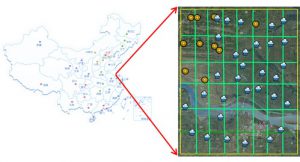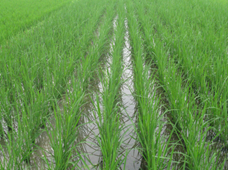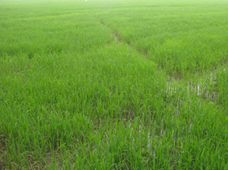Overview
Project Objectives
Estimating Crop Area
Operational Implementation Plan
Crop identification and Crop Area Estimation: Identify rice fields with its polarimetric responses and scattering mechanisms and estimate the rice acreage accurately.
Field size measurement
Estimating Crop Conditions
Operational Implementation Plan
Project Overview Implementation Plans Site Description Specific Project Objectives & Deliverables In Situ Observations EO Data Requirements Project Reports Study Team View/Print All JECAM – Sidebar Image Project Overview Crop identification and Crop Area Estimation: Identify rice fields with its polarimetric responses and scattering mechanisms and estimate the rice acreage accurately. Crop Condition/Stress: Rice phenological stage retrieval, providing timely and accurate information about rice growth condition, in order to plan cultivation practices (irrigation, fertilization, etc.).
Crop Conditions
Measuring Phenological Events
Phenological Events
- Seeding
- Seedling
- Vegetative Growth
- Flowering
- Fruit Development
- Maturity
- Harvest
Forecasting Agricultural Variables
Operational Implementation Plan
Yield Prediction and Forecasting: A quantitative relationship between polarization variables and rice key parameters (biomass, LAI) will be established. Then, a crop model, taking into account the variation of the time – domain and environmental stress, will be employed for rice yield prediction.
Agricultural Variables (large scale)
- Yield
Site Description
| Landscape Topography | Plain |
|---|---|
| Typical Field Size | |
| Climatic Zone | Subtropics, cold |
| Major Crops and Calendars | Rice (Normal): |
| Soil Type & Texture | Inorganic:
|
| Soil Drainage Class | |
| Irrigation Infrastructure | |
| Other Site Details | The terrain is flat, with the average altitude mostly less than 10m. The climate belongs to the transition region between the subtropical and the temperate zone, with four distinct seasons. The annual average temperature of the test site is about 13 to 16?. The average precipitation is about 800 to 1200 mm every year, and more than half of the precipitation occurs from June to September. The sunshine hours can be up to 2400 every year. The soil type of this region is mostly yellow brown clay, which is more favorable for rice plant development. The main paddy varieties in this area are hybrid and japonica rice. There is one rice crop a year, with the growth cycle about 150 days, from early June to late October or early November. There are two rice planting methods in the test site, transplanting and direct-seedling, which will produce two different rice field structures (Fig 2(a) (b)) and have a certain impact on rice yields. The size of rice field parcels is 1700m2 or so. In this study, forty-two sample plots were selected in the test site, covering twenty-nine transplanting fields and thirteen direct-seedling fields. The distribution of these sample plots is also showed in Fig 1.
Figure 2. Rice fields in Jiangsu test site |
In Situ Observations
Weight of a panicle (moist, dry)
- Crop Type(s):
- Collection Protocol:
Field sampling, measured by balance
- Frequency: Four times during experiment cycle
Plant Bunch distance
- Crop Type(s):
- Collection Protocol:
Measured by steel ruler
- Frequency: Ten times during experiment cycle
Number of Leaf/stem
- Crop Type(s):
- Collection Protocol:
Select a few stems randomly, count the number, then calculate the value per stem
- Frequency: Ten times during experiment cycle
Moist weight and Dry height/bunch
- Crop Type(s):
- Collection Protocol:
Field sampling, measured by drying method
- Frequency: Ten times during experiment cycle
Leaf length, width and thickness
- Crop Type(s):
- Collection Protocol:
Measured by vernier caliper
- Frequency: Ten times during experiment cycle
Number of stem/bunch
- Crop Type(s):
- Collection Protocol:
Select a few bunches randomly, count the number, then calculate the value per bunch
- Frequency: Ten times during experiment cycle
Paddy variety
- Crop Type(s):
- Collection Protocol:
Obtain through field measurements
- Frequency: Once during experiment cycle
Number of Panicle/bunch
- Crop Type(s):
- Collection Protocol:
Select a few bunches randomly, count the number, then calculate the value per bunch
- Frequency: Four times during experiment cycle
Stem diameter
- Crop Type(s):
- Collection Protocol:
Measured by vernier caliper
- Frequency: Ten times during experiment cycle
Method of planting
- Crop Type(s):
- Collection Protocol:
Obtain through field measurements
- Frequency: Once during experiment cycle
Panicle length
- Crop Type(s):
- Collection Protocol:
Measured by steel ruler
- Frequency: Four times during experiment cycle
Stem inclination
- Crop Type(s):
- Collection Protocol:
Estimation using compass
- Frequency: Ten times during experiment cycle
Sowing date
- Crop Type(s):
- Collection Protocol:
Obtain through field measurements
- Frequency: Once during experiment cycle
Panicle angle
- Crop Type(s):
- Collection Protocol:
Estimation using compass
- Frequency: Four times during experiment cycle
Plant height
- Crop Type(s):
- Collection Protocol:
measured by steel ruler
- Frequency: Ten times during experiment cycle
Water layer height
- Crop Type(s):
- Collection Protocol:
Measured by vernier caliper
- Frequency: Six times during experiment cycle
Number of grain/panicle
- Crop Type(s):
- Collection Protocol:
Select a few panicles randomly, count the number, then calculate the value per panicle
- Frequency: Four times during experiment cycle
Number of Bunch/m2
- Crop Type(s):
- Collection Protocol:
Select a field randomly, count the number, then calculate the value per square meter
- Frequency: Ten times during experiment cycle
Soil condition
- Crop Type(s):
- Collection Protocol:
Observation, field sampling, measured by drying method
- Frequency: Ten times during experiment cycle
Dimensions of grains (length, width)
- Crop Type(s):
- Collection Protocol:
Measured by vernier caliper
- Frequency: Four times during experiment cycle
Bunch diameter
- Crop Type(s):
- Collection Protocol:
Measured by vernier caliper
- Frequency: Ten times during experiment cycle
Leaf insertion angle
- Crop Type(s):
- Collection Protocol:
Estimation using compass
- Frequency: Ten times during experiment cycle
EO Data
Optical Data Requirements
SAR Data Requirements
Passive Microwave Data Requirements
Thermal Data Requirements
Results
Documents and Files
Links to paper
Project Reports
Study Team
Team Leader
Other Team Members




